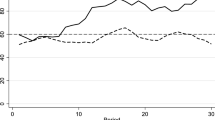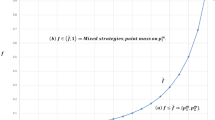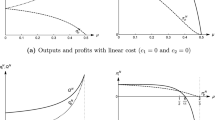Abstract
This paper presents and tests a simple model of competitive and unilateral market power regimes that yields countercyclical markups. Following a decrease in demand in the short run, capacity-constrained firms may have a strong incentive not to lower their prices to the new competitive price. Demand shocks may introduce market power into a previously competitive market. Experimental posted offer markets support this conjecture with complete information on the market structure. With only private information, there appears to be a hysteresis effect concerning supracompetitive prices, i.e., markets with a history of supracompetitive pricing continue to generate supracompetitive prices following demand shocks. However, competitive markets also remain competitive following demand shocks when firms only have private information on costs and capacities.
Similar content being viewed by others
References
Bagwell, K. and Staiger, R. (1997). “Collusion over the Business Cycle.” The Rand Journal of Economics. 28, 82-106.
Davis, D., Harrison, G., and Williams, A. (1993). “The Effects of Nonstationarities on the Convergence to Competitive Equilibria.” Journal of Economic Behavior and Organization. 20, 1-22.
Davis, D. and Holt, C. (1994). “Market Power in Laboratory Markets with Posted Prices.” The Rand Journal of Economics. 25, 467-487.
Davis, D. and Holt, C. (1997). “Price Rigidities and Institutional Variations in Markets with Posted Prices.” Economic Theory.9, 63-80.
Freund, John E. (1992). Mathematical Statistics.5th ed. Englewood Cliffs. NJ: Prentice Hall.
Hamilton, J.D. (1989). “A New Approach to the Economic Analysis of Nonstationary Time Series and the Business Cycle.” Econometrica. 57(2), 357-384.
Holt, C. (1989). “The Exercise of Market Power in Laboratory Experiments.” Journal of Law and Economics. 32, S107-S130.
Kandori, M. (1991). “Correlated Demand Shocks and Price Wars during Booms.” Review of Economic Studies. 58, 171-180.
Ketcham, Smith J.V., and Williams, A. (1984). “A Comparison of Posted-Offer and Double-Auction Pricing Institutions.” Review of Economic Studies. 51, 595-614.
Kreps, D.M. and Scheinkman, J.A. (1983). “Quantity Precommitment and Bertrand Competition Yield Cournot Outcomes.” Bell Journal of Economics. 14, 326-337.
Kruse, J., Rassenti, S., Reynolds, S., and Smith, V. (1994). “Bertrand-Edgeworth Competition in Experimental Markets.” Econometrica. 62, 343-372.
Levitan, R. and Shubik, M. (1972). “Price Duopoly and Capacity Constraints.” International Economic Review. 13, 111-122.
Mestelman, S. and Welland, J. (1994). “Price Flexibility and Market Performance in Experimental Markets.” Economic Theory. 4, 105-129.
Reynolds, S. and Wilson, B. (1997). “Market Power, Price Markups, and Capacity Investment Under Uncertain Demand.” Working Paper, University of Arizona.
Rotemberg, J. and Saloner, G. (1986). “A Supergame-Theoretic Model of Price Wars during Booms.” American Economic Review. 76, 390-407.
Staiger, R. and Wolak, F. (1992). “Collusive Pricing with Capacity Constraints in the Presence of Demand Uncertainty.” The Rand Journal of Economics. 23, 203-220.
Wilson, B. and Reynolds, S. (1998). “Price Movements over the Business Cycle in U.S. Manufacturing Industries.” Federal Trade Commission Working Paper # 219.
Author information
Authors and Affiliations
Rights and permissions
About this article
Cite this article
Wilson, B.J. What Collusion? Unilateral Market Power as a Catalyst for Countercyclical Markups. Experimental Economics 1, 133–145 (1998). https://doi.org/10.1023/A:1009972125288
Issue Date:
DOI: https://doi.org/10.1023/A:1009972125288




